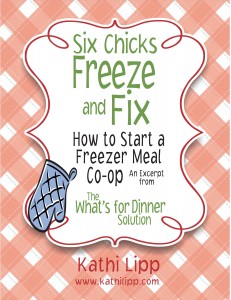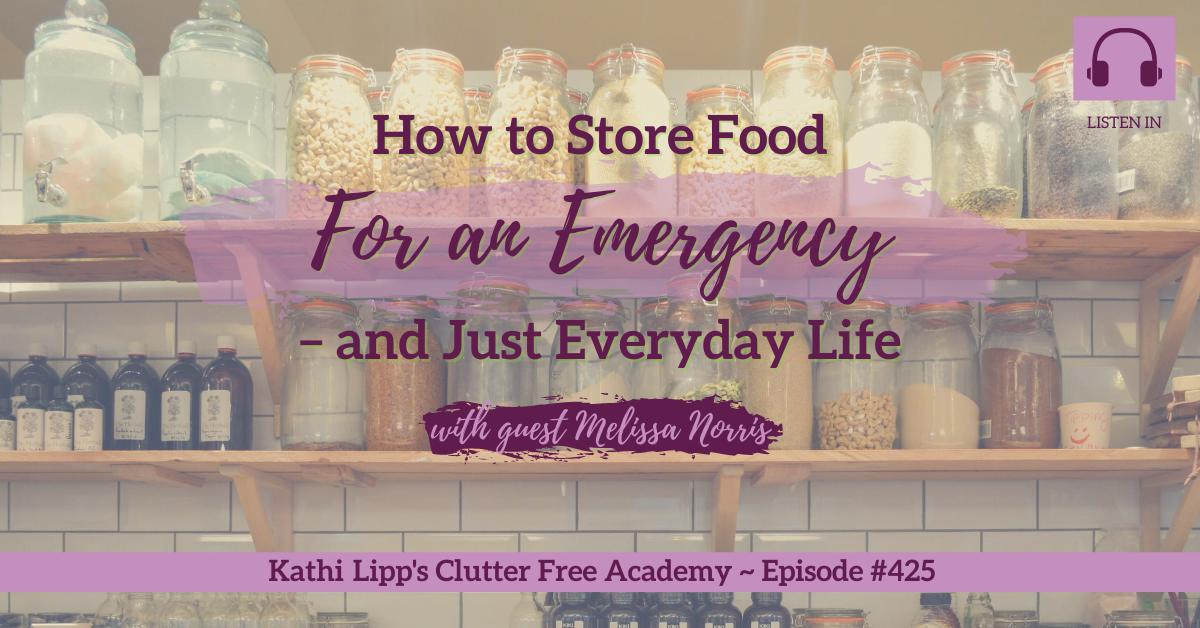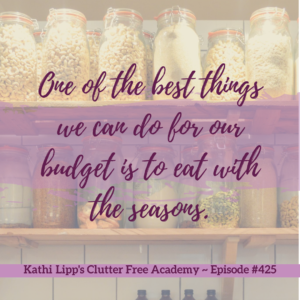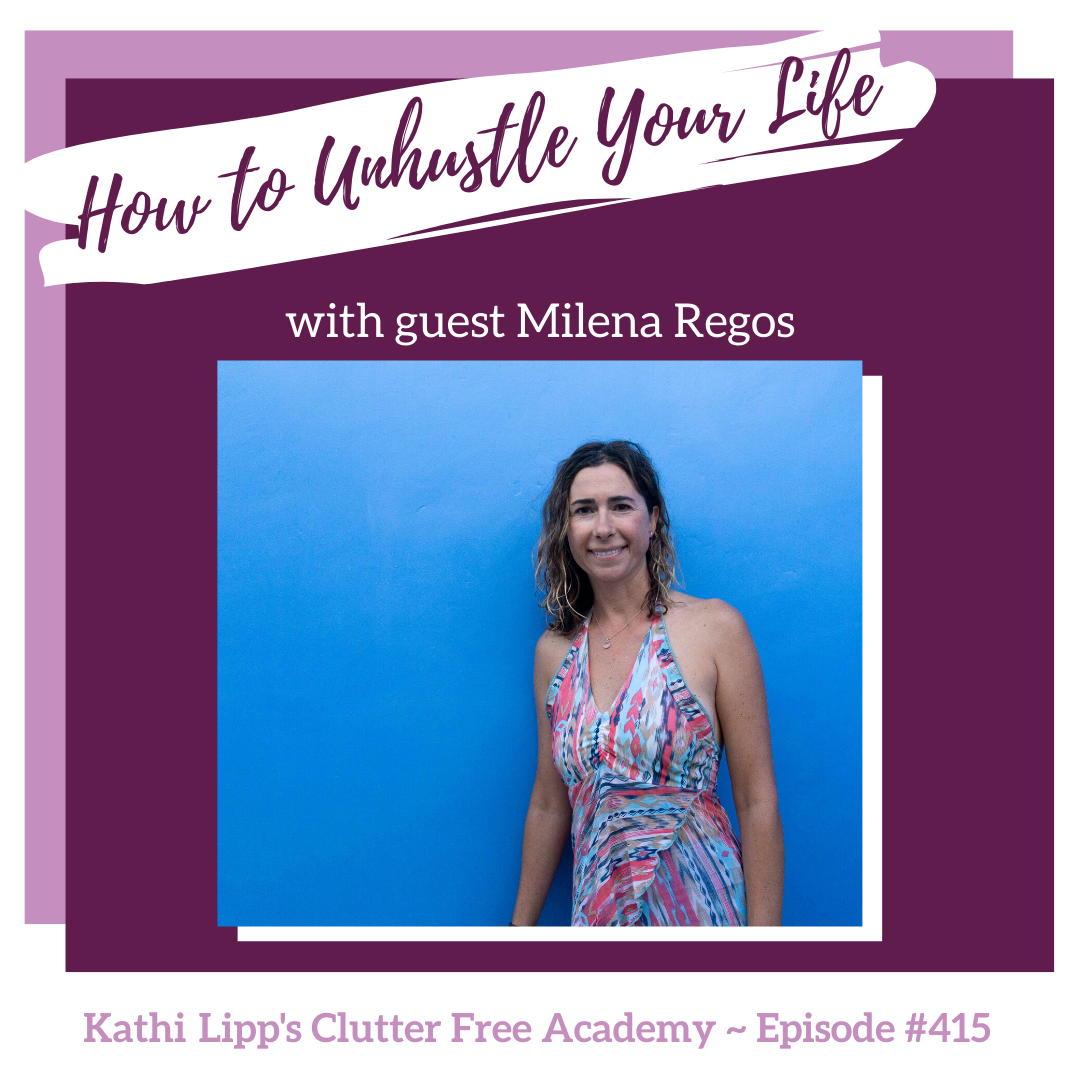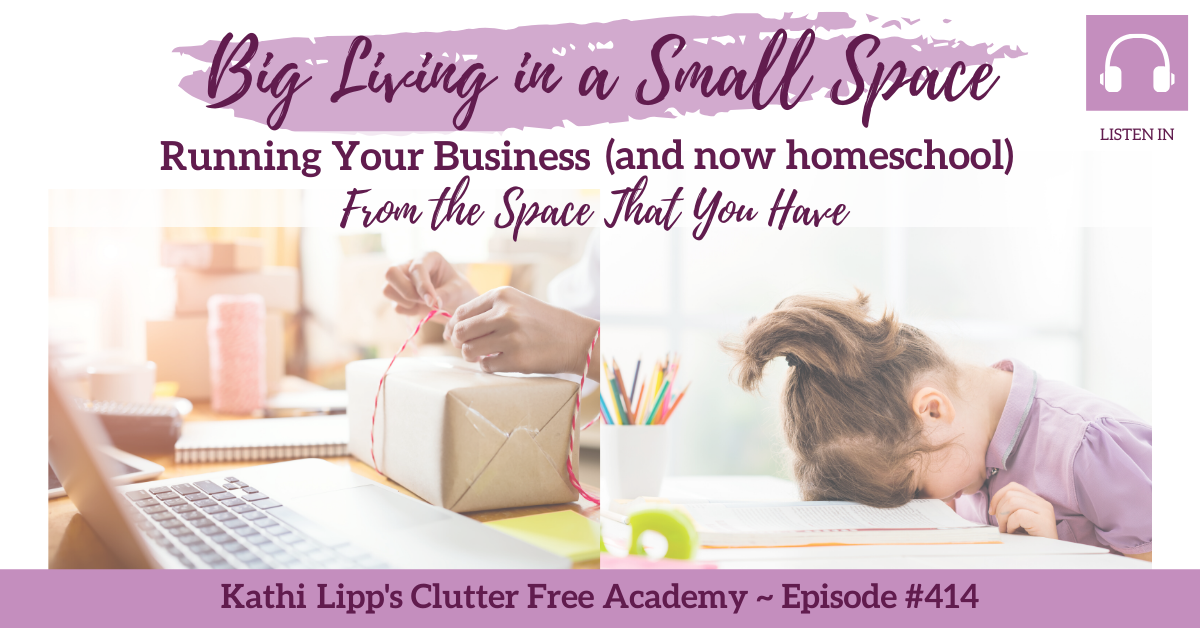Read along with the podcast!
Clutter Free Academy Podcast #394
Clutter Free Home – Declutter
<<intro music>>
Kathi – Well, hey friends! Welcome to Clutter Free Academy, where our goal is to help you take small, doable steps to live every day with less clutter and more life. My name is Kathi Lipp. I’m the author of Clutter Free and here with me is the founder of Clutter Free Academy on Facebook, it is Tonya Kubo. Hey, Tonya!
Tonya – Hey, Kathi!
Kathi – I am so excited. We are in a series right now, because we are talking about my book that is coming out. It is The Clutter Free Home. I really do know the title of it. It’s coming out a week from today.
Tonya – What?!
Kathi – I know. I’m super excited. So, we’ve got our launch team. If you haven’t gone over there, let’s make sure you’ve got all the information for that. Today, we’re talking about the third step in the book. It’s been really fun to test this out with our Clutter Free for Life. I call them Guinea Pigs, you called them Early Adopters. So they’ve been doing this for over a year and making such huge progress. It’s been super fun to watch. We want to talk about our decluttering system for The Clutter Free Home.
Tonya – Sigh. It’s so fitting for Clutter Free Academy to talk about decluttering.
Kathi – Yes! Finally! We’ve talked about dedicating your space; really understanding what your space is about and how you’re using it. Decide. How do you want that space to feel/look/smell/all the things? Now, we’re going to declutter. The new decluttering system has two parts. It’s always had two parts, but we want to talk about daily decluttering and then deep decluttering. Daily decluttering? Fifteen minutes. Get ‘er done.
Tonya – Yep!
Kathi – So, that’s the basis of everything we’ve ever done in Clutter Free. Would you talk through what you do in those fifteen minutes? ‘Cause you’ve been doing this for five years.
Tonya – Yeah, so I think the first thing I do is decide what I’m going to do. Because it’s fifteen minutes – I’ll use my bedroom as an example ‘cause I love to use my bedroom as an example – fifteen minutes is enough time to tackle one drawer in my dresser or my closet.
Kathi – One drawer in your closet. Or one area in your closet.
Tonya – What I was going to say is, if I have a very specific purpose in my closet. So, I’ll do a fifteen minute session and say, “I’m going to get rid of everything that is worn or I no longer love.” Right? I’ll have my trash bag already there, and I’ll get everything situated to give away or to toss. I set my timer for fifteen minutes, and I just go through. It’s no mercy, because I’ve already pre-decided “This is what I’m doing. This is why I’m going to do it. This is how long I’m doing it.” Then, at the end of the fifteen minutes, I set another timer for 5 minutes, and it’s a mad dash to get those bags out to the car and get back in. Then, I’m done. I’m not the person who’s going to do the marathon. I’m not going to set my timer for another 15 minutes.
Kathi – ‘Cause we’ve done that before.
Tonya – And it never ended well.
Kathi – No. It was always a bad thing. So, that’s our daily decluttering. But we, now, want to assign you a room. We want you to know that, when you’re doing your daily decluttering, there’s a schedule. So, we’re not just letting you go willy nilly, and you’re like, “I’ll do the laundry room, because that’s easy.” No no no. We’re going to assign you. Monday is your kitchen. I love this, because it starts out the week on a fresh note. So, for 15 minutes, I want you to get in there and declutter your kitchen. Make it all the things you want it to be. Tuesday is your living room. You’re getting in there. It’s just one shelf. One drawer. One something in your living room. Wednesday is your bedroom. This could be your bedroom or a kid’s bedroom or maybe a guest bedroom. How much time do you spend in your bedroom versus your girls’ bedroom?
Tonya – I spend more time in my bedroom. We only have a two bedroom house, so the bedrooms get a lot of use. But more time in mine, because I need to sleep well. I don’t sleep well when I’m overwhelmed with stuff in my room.
Kathi – Yeah. If you’re afraid you’re going to trip and die in the middle of the night, it’s not a good way to live. It just isn’t. Okay, so you’re going to pick one bedroom. It’s not like you’re doing fifteen minutes in each bedroom. You’re just trying to declutter and get the stuff out of there. Okay, Thursday is bathrooms. So, it depends. Is it your master bathroom? Your half bathroom downstairs? The kids’ bathroom? Whatever it is. This is not cleaning time. This is decluttering time. This is getting stuff out of your space. Then, Friday is office area. Even if your office area is your kitchen. Wherever you do your office. Wherever you do your paperwork. That needs to be decluttered on the regular. In San Jose, our office area is, really, the third bedroom, where Roger works. I have an office too, but for our household, bills and mail and things like that, that’s the third bedroom. Here at The Red House, Roger has an office upstairs, but we have a closet that has all of our paperwork. All that kind of stuff. So, that’s where I spend my fifteen minutes. It’s just more detailed. It’s more detailed to do it in there. Okay, and Saturday is extra. So this could be your garage, your basement, your attic. If you have a storage unit, I would suggest you go over there and spend your fifteen minutes cleaning it out, doing what you need to do. Sundays you get off. Now, if your work schedule is such that Tuesday is your day of rest? Figure it out. You guys are all adults. You can figure this out. What’s going to work? Nobody’s going to come to your house and make sure you’re decluttering on Tuesday in the living room.
Tonya – Right.
Kathi – We want you to be able to do all the things. So, that’s the first part. That’s the daily decluttering. Then, once a week, I want you to do a deep declutter. This is where you can get your hands dirty. We’re going to say sixty minutes. Here’s what I mean by that: You are going to deep declutter for 60 minutes. This is 60 minutes of getting stuff out of your house. I feel like once a week, I could do sixty minutes without analysis paralysis.
Tonya – Right.
Kathi – ‘Cause you’re picking the spot in your house. My recommendation is: If your garage is driving you crazy, every week you do your sixty minutes in there, until you’re about 60% decluttered. Then, if you need to, move on to another space. Do it until you see a difference in there.
Tonya – Right. And can I dig into that a little tiny bit? I know that in Clutter Free for Life this has been a challenge. First of all, we’ve talked about realistic expectations before, people think “All I need is an hour and I’m supposed to get the whole room situated.” Then they get a little bit discourage when that doesn’t happen. I liked what you said, and I want to dig into that a little. You’re decluttering for an hour. That whole goal of that hour is to get stuff out. The goal is not to color code your drawers. The goal is not to sit there and match socks. The goal is to get the single socks into a bag and out of the house. The goal is to get, if you’re in my house, and you’ve got underwear from size four all the way to size eight. It’s to get the underwear out that the youngest one is not going to wear, because there’s nobody else.
Kathi – There’s nobody else coming along to claim that underwear.
Tonya – And I’m never going to fit in size four toddler underwear. That’s just not going to happen.
Kathi – Nope. It’s not going to happen. So, at some point, when you’ve got your place decluttered enough, you can start to do the organization that will help you out. But here’s what people do: They try to organize their clutter. They go in and say, “We’re going to go in and put a system in place in this closet.” But, here’s the thing. You’re organizing things that are junk. Anytime you try to organize junk, it just explodes on you.
Tonya – Can I share a personal example?
Kathi – Of course.
Tonya – Okay, so most of our listeners know that we moved into a house that was built in 1952. What I don’t think listeners know is that they sold us everything in the house. As somebody who grew up in a studio apartment with my kind of background, I didn’t really believe that the house was ours, for a while. It’s taken me awhile, right? So, I have not touched anything they left.
Kathi – What do you mean?
Tonya – So, we have two closets in the house. We have one in the bathroom and we have one in the hallway. So, if you open the hallway closet, the shelves are stuffed with their linens.
Kathi – Whoa.
Tonya – So, they left their curtains and their sheets and everything. I’ve never touched them. I haven’t even pulled them out and folded them to see if they would fit my bed. It’s been this shrine. So, I’ve been losing very precious space in my hallway, because I’m just like, “I just don’t believe they’re not going to come back and want their stuff.” Which, by the way, they don’t. I actually did ask. But as I’m sitting here, thinking, that would be the perfect use of an hour. I would get four shelves back.
Kathi – Yes. I’m going to hold you accountable for this.
Tonya – I wish our listeners could see your face. Kathi is very concerned for me, right now.
Kathi – Can I just tell you? The house is yours.
Tonya – But, I think our listeners will appreciate the fact that there is a lot of ‘pinch ourselves’, right, in our decluttering journey? I just want to give hope to the listener who feels like they just can’t let stuff go.
Kathi – Can I just tell you, no judgement? There’s no judgement.
Tonya – Oh, no. I don’t feel judgement. But, I laugh because I’ve been in this journey a long time. It wasn’t until you were talking about that just now. You were talking about the storage unit, and I was like, “That’s basically a storage unit inside my house.”
Kathi – It totally is.
Tonya – I open the cabinet and I go, “Yeah, no, I’m just going to close that.”
Kathi – So, here’s my question for you. This is one of the things I don’t think we talk enough about in Clutter Free Academy, but I think it would be super helpful. What is your vision for that closet? What could that become for you?
Tonya – I want that to be, it sounds silly, but I want my paper towels and my cleaning stuff to go there, because it’s so centrally located for the home. I’ve thought, over time, “Oh, that’s where blankets should go. Oh, that’s where towels should go.” That’s not actually where I want those things. I don’t want to trip over the Costco package of paper towels that are left on the floor because I don’t have any other shelves that are tall enough. But I do in there. It’s just funny to me how, again, I’ve lived there over a year, and it’s never occurred to me.
Kathi – But isn’t that how we are? We have shrines in our own house.
Tonya – Right. We talked about this before, right? We let the house happen to us. I love that this is a way to take ownership.
Kathi – Okay, so in the next two months, could you declutter that closet?
Tonya – Well, I could probably do it in the next weekend. None of the stuff is mine. I can’t even imagine wanting to keep any of it because it doesn’t belong to me.
Kathi – It’s just a big old Goodwill run.
Tonya – Yeah. I really think so. How funny is this? I’m tickled by myself right now.
Kathi – Yeah! No! I totally get it, though. I really do. There are things, even in this Red House. We have a barn. Okay, that’s weird. We have a barn. But, I don’t know exactly what’s out there.
Tonya – Right, ‘cause you’re in the same situation, where they sold a lot of the stuff to you.
Kathi – Yeah, it’s a very unusual circumstance. You’re like, “Should I keep this? I don’t even know what it’s for.” But, it’s like, “Is that the key for keeping the whole house together?” So, part of it is research to find out, “What is this doohickey?” I’ve gone through everything in our garage. I’ve touched everything in the garage. I know what’s in there. The barn is still a bit of a mystery to me. We will uncover these things together, Tonya.
Tonya – That’s what I like about Clutter Free Academy, though, right? We do this together.
Kathi – Yes. Okay, so I’m super excited about this, guys. We want you to join the journey with us. So, if you have ordered a copy of the book, go ahead and preorder. That is super helpful to us as authors.
Tonya – Yes it is.
Kathi – But, also, I would love for you to be on this journey with us. We will be telling your more about that. So, Tonya, thanks for being here.
Tonya – Thanks for having me.
Kathi – And friend, thank you for being here. You’ve been listening to Clutter Free Academy. I’m Kathi Lipp. Now, go create the clutter free life you were always intended to live.
<<music>>
*see show notes in podcast post above for any mentioned items

 Bad stuff happens all the time, but this doesn’t mean we have to live in constant fear.
Bad stuff happens all the time, but this doesn’t mean we have to live in constant fear.
